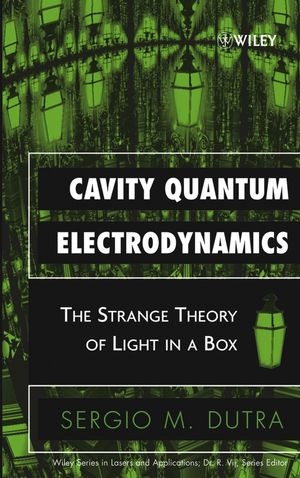
Cavity Quantum Electrodynamics
Wiley-Interscience (Verlag)
978-0-471-44338-4 (ISBN)
What happens to light when it is trapped in a box?
Cavity Quantum Electrodynamics addresses a fascinating question in physics: what happens to light, and in particular to its interaction with matter, when it is trapped inside a box? With the aid of a model-building approach, readers discover the answer to this question and come to appreciate its important applications in computing, cryptography, quantum teleportation, and opto-electronics. Instead of taking a traditional approach that requires readers to first master a series of seemingly unconnected mathematical techniques, this book engages the readers' interest and imagination by going straight to the point, introducing the mathematics along the way as needed. Appendices are provided for the additional mathematical theory.
Researchers, scientists, and students of modern physics can refer to Cavity Quantum Electrodynamics and examine the field thoroughly. Several key topics covered that readers cannot find in any other quantum optics book include:
* Introduction to the problem of the "vacuum catastrophe" and the cosmological constant
* Detailed up-to-date account of cavity QED lasers and thresholdless lasing
* Examination of cavities with movable walls
* First-principles discussion about cavity QED in open cavities
* Pedagogical account of microscopic quantization in dielectrics
Complementing the coverage of the most advanced theory and techniques, the author provides context by discussing the historical evolution of the field and its discoveries. In that spirit, "recommended reading," provided in each chapter, leads readers to both contemporary literature as well as key historical papers.
Despite being one of many specialties within physics, cavity quantum electrodynamics serves as a window to many of the fundamental issues of physics. Cavity Quantum Electrodynamics will serve as an excellent resource for advanced undergraduate quantum mechanics courses as well as for graduate students, researchers, and scientists who need a comprehensive introduction to the field.
SERGIO M. DUTRA's passion for quantum optics dates back to 1989. He received a PhD from Imperial College, London, studying cavity quantum electrodynamics. Dr. Dutra is a Chartered Physicist and a member of the British Institute of Physics. He has worked at Campinas University in Brazil and Leiden University in the Netherlands, published a number of papers in peer-reviewed international journals, a chapter of a book, and spoken at conferences in several countries.
Preface. Acknowledgments.
1. Introduction.
2. Fiat Lux!
3. The Photon's Wavefunction.
4. A Box of Photons.
5. Let Matter Be!
6. Spontaneous Emission.
7. Macroscopic QED.
8. The Maser, the Laser, and their Cavity-QED Cousins.
9. Open Cavities.
Appendix A: Perfect Cavity Modes.
Appendix B: Perfect Cavity Boundary Conditions.
Appendix C: Quaternions and Special Relativity.
Appendix D: The Baker-Hausdorff Formula.
Appendix E: Vectors and Vector Identities.
Appendix F: The Good, the Bad, and the Ugly.
References.
Index.
| Erscheint lt. Verlag | 18.1.2005 |
|---|---|
| Reihe/Serie | Wiley Series in Lasers and Applications ; 1 |
| Zusatzinfo | Photos: 0 B&W, 0 Color; Drawings: 0 B&W, 0 Color |
| Sprache | englisch |
| Maße | 160 x 238 mm |
| Gewicht | 699 g |
| Themenwelt | Naturwissenschaften ► Physik / Astronomie ► Elektrodynamik |
| Naturwissenschaften ► Physik / Astronomie ► Theoretische Physik | |
| ISBN-10 | 0-471-44338-7 / 0471443387 |
| ISBN-13 | 978-0-471-44338-4 / 9780471443384 |
| Zustand | Neuware |
| Haben Sie eine Frage zum Produkt? |
aus dem Bereich


